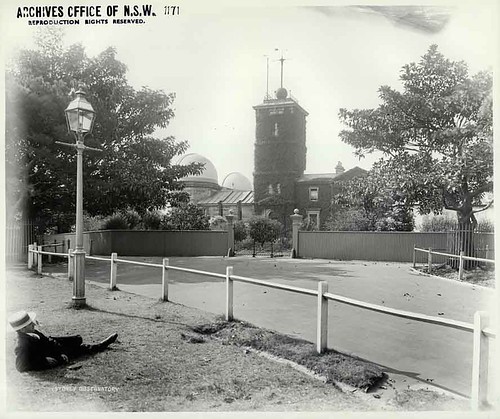I found the environmental calculators made available by the Image Permanence Institute to be tremendously helpful so I thought I would share.
Happy 80th Birthday Sydney Harbour Bridge!
This year we are trying something a little different. We have created an I <3 Sydney Harbour Bridge tribute board at Pinterest.com. The aim is to get together a collage of images both from our own collection and other peoples (where copyright has been made available).
This is where you come in!
Grant Applications open for indexing records of Forgotten Australians and Former Child Migrants
The Find and Connect Records Access Documentation Project will provide cash grants of up to $15,000 to eligible not-for-profit organisations to document, index and release records relating to children placed in Homes, orphanages and other forms of out-of-home ‘care’ during the 1920s–1980
Darwin WWII Bombing: 70 years later
Darwin 70 years on
This is a concise 3 minute overview of the history of the bombing of Darwin in 1942 and its subsequent impact. I would highly recommend it to those unfamiliar with the history.
Military historian Tom Lewis discusses the 70th anniversary of the Japanese attack on Darwin during World War II on ABC News.
Moments and memories
ABC news are also the authors of a comprehensive page on the Darwin bombings which includes an eyewitness account from a veteran, a then and now audio slide show and an interactive map with photo’s and audio.
On February 19, 1942, shortly before 10:00am, Japanese forces launched air raids on Darwin, the first on Australian soil.
More than 260 enemy planes, including land-based bombers and planes flying off aircraft carriers in the Timor Sea, attacked US and Australian shipping, the town’s harbour, military and civil aerodromes and the local hospital.
The attacks, which came in two waves, were part of Japan’s efforts to damage Australia’s morale, hinder Darwin’s use as a military base, and ultimately secure neighbouring Timor.
At least 243 people were killed in the attack, and up to 400 people were injured.
Twenty military aircraft were destroyed and eight ships in the harbour were sunk.
Air attacks continued over a space of almost two years, with about half of Darwin’s population ultimately fleeing south.
Director, Alan Ventress, discusses the disappearing skill of reading handwriting
Some of you may be aware that the Director of State Records NSW, Alan Ventress, has been in the media this week discussing the subject of the disappearing skill of reading handwriting.
It all started with a letter published in the Sydney Morning Herald on Tuesday.
You wouldn’t read about it – they can’t
Not only can’t the under-30s write running writing, the number who can’t read it is growing exponentially (Letters, February 6).
Here at State Records NSW we have about 8 million individual items in the state’s archives, many of which were written in cursive script in the 18th and 19th centuries.
This was followed by three responses published yesterday.
History of literacy turns another page
Alan Ventress states that ”unless it is written in 12-point Times New Roman, younger users of the archives are unable to research Australian history” (Letters, February 7). That is patently untrue – they are also fluent in Arial, Comic Sans and, of course, txt.
Read more: http://www.smh.com.au/national/letters/rudd-will-just-bring-forward-the-demise-of-labor-20120207-1r5qa.html#ixzz1lpcYVKda
It remained a popular topic for letters again today.
In 13 years of schooling, Terry Funnell’s law student (Letters, February 8) had studied global warming but not cursive writing. I hope they taught him to swim.
At lunch time yesterday Alan Ventress was interviewed on the subject by James Valentine on Radio Station ABC 702 Sydney.
We spoke to Alan Ventress from the State Records about how people are struggling to read the old handwriting in the records and also took your calls on how the art of reading and indeed writing “running writing” is diminishing.
Long time readers of Archives Outside will also know that deciphering handwriting is a subject near and dear to our hearts. With your help we successfully crowdsourced a page with some handy tips and tricks.
Digital archaeology and the temporary nature of technology
This post is brought to you via State Records newest Board Member Stephen Choularton Ph.D., FIoD who recommended this podcast on the Radio National site! It’s a fascinating introductory look at the world of digital archaeology, touching on several issues that are central to the mission of Archives.
As our fast paced digital world continues what does that mean for the way we think about preserving things like old webpages and obsolete media formats? Are there possible lessons from our digital past for our digital future? We explore the fragility of our electronic data and also the temporary nature of the technology we use to access it. We also join the excavation of a 1970s computer chip called the 6502!
ETA: Podcast link updated 23/02/12
Happy Summer Hiatus Post! (with added bonus feature “Find The Stror ‘At Coot” )
It’s hard to believe it’s that time of year already! Here at Archives Outside we would like to say thanks to everyone who has contributed, commented and read the blog over the past year and wish you all the best for 2012. The blog will be going on a summer hiatus until Monday 30th of January when we will start-up again with a Moments in Time post. However, our photographic fans should fear not. While Can you date this photograph? [Clovelly Beach] was our last formal photo post for the year we are leaving you with a puzzle for the lazy summer days to come.
Joy, luck and love
Anthea, Anna & Fiona
(The Archives Outside team)
Can you find “The Stror ‘At Coot”?
By Jenny Sloggett
With apologies to CJ Dennis.
The Kid is looking for the Straw Hat Coot who has been dodging round Doreen; that ‘knock-kneed coot … Wiv ’is cute stror ’at an’ pretty ways!’ forever talking about ‘The Hoffis’. We think we’ve seen him lounging around in The Rocks, but not only there.
Can you help the kid? Is the Straw Hat Coot lurking elsewhere in State Records NSW’s photostream?
Generous Interfaces (a presentation by Mitchell Whitelaw)
A thought provoking presentation about interfaces for digital collections made by Associate Professor Mitchell Whitelaw from the University of Canberra at the recent National Digital Forum in New Zealand.
“Men and women of Australia, we are at war with Japan.” (70 years ago today)
On this day in 1941 Prime Minister John Curtain announced via Radio Broadcast that Australia was at war with Japan.


![Captain Moonlite - NRS906 Special Bundles [Colonial Secretary] - 1880 Letters of Scott "Moonlight" and Rogan written while awaiting execution in Darlinghurst Gaol ([4/825.2]; microfilm copy SR Reel 2868, photocopy City COD291 p.204)](/wp-content/uploads/2012/02/Captain-Moonlight.jpg)



